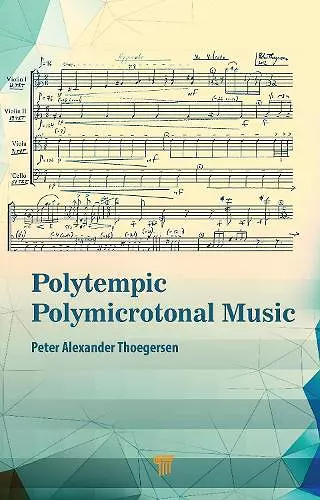Polytempic Polymicrotonal Music
Peter Alexander Thoegersen author
Format:Hardback
Publisher:Jenny Stanford Publishing
Published:8th Sep '22
Should be back in stock very soon

This book introduces polytempic polymicrotonality as a new musical aesthetic. It proposes music with more than one microtonal tuning system and discusses examples from the literature to give an historic framework showing that this tendency has been present throughout human musical history. Polytempo is a tool for which polymicrotonal structures can function in relief from its background, and it acts as a frame, or ground structure, that is multidimensional, akin to the advancement of perspective in Renaissance art. The book has historic significance as it is the only book of its category, or genre, in music that features polymicrotonality in music composition or production. It displays examples of music literature for musical precedence in this area, focusing on Charles Ives’s Universe Symphony, unfinished since 1925.
Gritty, uncompromising musical relations bound together by the intensity of my work with another musician to bring the sounds to life. I could imagine that some of the musical gestures could be achieved through heterophony yet that grittiness I felt acutely during rehearsals and performance of ‘Skullen a Coldie at the Servo with M8tes’ would have dissipated if the polytempic composing and performance expectation had been missing. The beauty of each instrument having its distinct yet related set of intervals is the pitch integrity that is both felt and heard almost as if we were co-conspirators in a theatrical plot. Working with both polytempi and polymicrotonality really brought an edginess to our performance and a determination to not only start and finish together but revel in the moments of near concordance and genuine contention.
Michael Dixon, hornist, co-founder and curator at Sydney Microfest (on performing polytempic polymicrotonal music of Peter Thoegersen)
Peter Thoegersen is a deeply passionate polytempic tuning wizard. Not content to follow the rules, Peter knocks on the door of mystery over and over again until he has uncovered and devoured a musical truth.
Johnny Reinhard, Director of American Festival of Microtonal Music
Anton Rovner Contemporary Music in Odessa: the Festival ‘Two Days and Two Nights of New Music’ in April 2017. The hit of the program was ‘Dreams like little Movies’ by Los Angeles–based composer Peter Thoegersen. An extensive, technically elaborate and virtuosic composition, it kept the attention of the audiences throughout the entire 17 minutes of its duration by its apt usage of the pitches of the 128 note scale, well thought out musical development, its contrasting textures and suturing musical dramaturgy.
Anton А. Rovner, PhD in music composition from Rutgers University (New Jersey, USA), Candidate of Arts (PhD) from the Moscow State Conservatory, faculty member at the Department of Interdisciplinary Specializations for Musicologists of Moscow State P. I. Tchaikovsky Conservatory ORCID: 0000-0002-5954-3996, [email protected]
Peter Thoegersen’s wide-ranging dissertation on multidimensional harmony and rhythm traces exotic musical ideas around the world and throughout history, from the ancient Chinese and Greeks to Tibetan ideas of the soul to American rhythmic experimenters like Henry Cowell and Charles Ives to almost totally forgotten microtonalists like Jean Étienne Marie. Yet for all his extraordinary erudition in the most rarefied of musical phenomena, he threads his sources into a network that maps out previously unknown vistas that musicians have barely begun to explore—vistas that he himself has been investigating in his own music.
Kyle Gann, author of Charles Ives’s Concord: Essays after a Sonata and The Arithmetic of Listening: Tuning Theory and History for the Impractical Musician
Peter Thoegersen’s Polytempic Polymicrotonal Music is a unique scholarly resource covering this absolutely fascinating subject. Centering on Charles Ives’ Universe Symphony as the ‘progenitor’ work of this musical research, the book covers in great detail the whole history of microtonality and rhythm from ancient times to the present. Thoegersen offers us an exploration of the history of and the current state of affairs with regard to polytempic polymicrotonal composition and, finally, to a radically new music of today and tomorrow that he, himself, as composer is currently exploring in his own compositions.
Gerard Pape, composer (on performing polytempic polymicrotonal music of Peter Thoegersen)
Peter Thoegersen’s solo for flute/polymicrotonal modulations slams the performer against a rock face, obscuring the few toeholds of familiar pitch reference. Alongside considerable technical demands, three active systems (18-tet, 24-tet, and 48-tet) evolve to form a fluidity that shatters the intuitive convention of the flute, the instrument, transformed to an open structure in the wind. This is important, complex (not complexist) music. The intellect behind it is considerable. It is far less concerned with being liked or enjoyed, instead, demanding us to ponder why we were so initially weak.
Carlton Vickers, flute soloist NO EXIT New Music Ensemble, Maurice Abravanel Visiting Distinguished Composers Series, Vertigo Ensemble
Polytempic Polymicrotonal Music contains beautiful narratives for which a minimum of knowledge is required. It is logical that the definition of microtonality must pass through musical intonation that is not the classic 12-note Western system. The book provides useful advice to understand on the basis of the microtonal theory. Divided into six chapters, the author first dwells on the historical significance of microtonality, then deals analytically with the subject in relation to the "tone", the "rhythm" and finally the analysis on the Universe Symphony by Charles Ives, an orchestral composition brought to the fore only towards the end of the twentieth century by Johnny Reinhard, who understands its importance in the context of polytempic and polymicrotonal art; not to forget, Jean Étienne Marie, a proponent of polymicrotonality, was discussed.
Ettore Garzia, Percorsi Musicali
ISBN: 9789814968294
Dimensions: unknown
Weight: 444g
180 pages